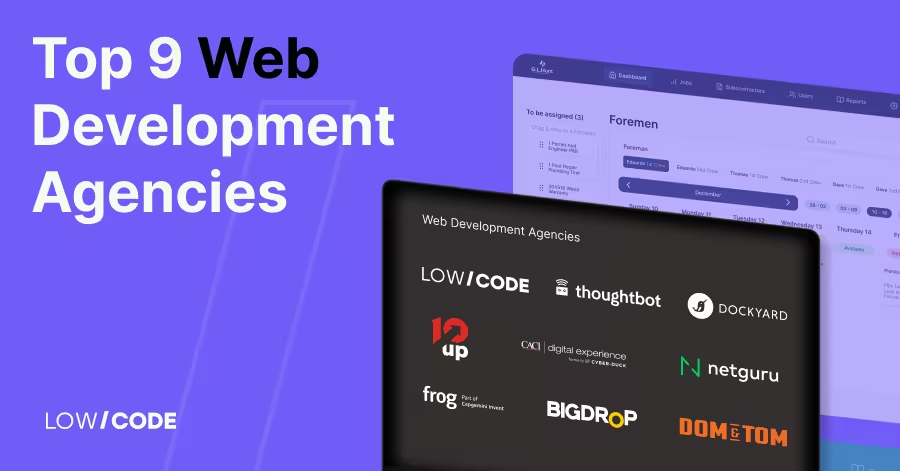When to use no-code/low-code development?
10 min
read
Analyzing the strengths and weaknesses of no-code and low-code development - key factors for you to make informed decisions.

Got a great app idea but don’t want to deal with complex coding? Low-code and no-code development might be the solution. These tools let you build apps faster, with little to no coding, making development easier and more accessible.
In this guide, we’ll explain when to use low-code and no-code, how they compare to traditional coding, and their biggest strengths. Whether you’re a business owner or just exploring app development, knowing the right approach can save time and effort.
We will also share real-world success stories of apps created using these methods. From simple automation tools to large-scale business applications, low-code and no-code are transforming how software is developed. Let’s explore how they can help turn your idea into reality—without spending months learning to code!
TL;DR: When to Use Low-code or No-code Development
- Use No-code for building full-featured apps, automating workflows, and launching scalable MVPs without coding. Ideal for businesses, startups, and internal tools.
- Use Low-code when you need custom backend logic, complex integrations, or enterprise-grade scalability. Best for IT teams and hybrid development.
Understanding no-code, low-code, and traditional coding
Before we dive into the practical applications of these development approaches, let's establish a clear understanding of each methodology and explore the unique characteristics and strengths of each approach. We’ll focus on key differences in terms of speed, customization, and complexity:

No-code development
No-code development allows users to create software through visual interfaces, pre-built components, and automation. No-code platforms eliminate the need for manual coding, focusing instead on rapid prototyping and simplifying the development process.
- Speed: Rapid application development is the hallmark of no-code. Projects can be completed at an astonishing pace, making it ideal for quickly bringing concepts to life.
- Customization: While it offers ease of use, no-code platforms may have limitations when it comes to highly specialized or complex functionalities. Customization is possible to a certain extent, but deep customization might require a different approach.
- Complexity: No-code is tailored for simplicity. It excels in creating straightforward applications and automating routine tasks, but it may not be the best choice for highly complex projects.
Learn more: What is no-code? A definition for 2023
Low-code development
Low-code development bridges the gap between traditional coding and no-code approaches. It offers a visual, streamlined development environment that reduces the amount of manual coding required. While developers can still write custom code when needed, low-code platforms provide pre-designed components and templates to accelerate the development process.
- Speed: Low-code offers faster development than traditional coding but may be slightly slower than no-code due to the need for some coding. However, it significantly accelerates the development process compared to traditional methods.
- Customization: Low-code strikes a balance between ease of use and customization. It's suitable for a wide range of projects, including those that require unique features.
- Complexity: Low-code platforms handle moderate complexity well. They are versatile enough for many business applications and can incorporate more intricate logic when needed.
Traditional coding
Traditional coding is the time-tested method where developers write custom code using programming languages like Python, Java, C++, etc. This approach offers complete control and flexibility, allowing developers to create highly customized solutions from scratch.
- Speed: Traditional coding may take longer to develop applications, particularly for complex projects. However, it offers complete control, making it essential for specific use cases.
- Customization: Traditional coding excels in customization. It's the go-to choice when you need full control over every aspect of an application and when building solutions with unique or intricate requirements.
- Complexity: Traditional coding can handle the highest levels of complexity, making it indispensable for projects with demanding technical specifications.
Learn more: Traditional Development vs. No-code/ Low-code
When to use no-code development
For rapid prototyping and MVP (Minimum Viable Product)
No-code development is an excellent choice when you need to quickly create a prototype or MVP to test your product concept. It allows you to build functional applications without writing code, enabling rapid iteration and experimentation. This is particularly valuable in the early stages of product development when you want to validate your ideas with minimal time and resources.
We can help you launch your MVP in only four weeks! Check out our MVP development services
SMEs and startups
Small and medium-sized enterprises (SMEs) and startups often operate with limited budgets and technical expertise. No-code development empowers them to create custom software solutions without the need for a dedicated development team. It provides a cost-effective way to automate processes, manage data, or build simple web applications to support their business operations.
Content-driven platforms
No-code development is well-suited for content-driven platforms such as blogs, e-commerce websites, and content management systems. These platforms require frequent updates and content additions, which can be efficiently managed through no-code tools. Content creators and site administrators can easily make changes and additions without relying on developers, speeding up content delivery and updates.
Real-life examples of no-code development
Give Local
GiveLocal is a wonderful example of the power of no-code. In just three days, Brent Summers developed GiveLocal, a web app that connected local restaurants with patrons, enabling them to purchase digital gift cards. As Summers puts it, the speed of development was the key: "The thing that makes no-code so powerful is the speed of development." He explains further, "The number one mistake I see first-time entrepreneurs make is they don’t use speed in the right way. They spend months fiddling with their app because they want to get it perfect before launching. I used Bubble’s speed to actually get that advantage when it comes to getting something out there fast."

GiveLocal had an almost immediate and deep impact. It caught the attention of USA Today, which recognized the platform's potential and acquired it. They rebranded it as Support Local, and expanded its functionality, while Summers remains actively involved, offering his expertise and guidance to the team.
Teal
Teal, led by founder and CEO David Fano, is a platform that helps users organize their job search, track various job opportunities, and gain valuable insights to enhance their resumes for specific roles.

It was built using a combination of no-code stack that includes Bubble.io, Airtable, and Zapier and has achieved remarkable success, including raising $11 million in investment. David emphasizes that design mockups, while valuable, can now be transformed into fully functional products using no-code tools. The beauty of this approach is not limited to speed; it extends to team collaboration. With a small team of only 12 members, Teal leveraged no-code capabilities to involve everyone in building out the product.
When to use low-code development
Enterprise-level solutions
Low-code development shines when it comes to building complex, enterprise-level solutions. These solutions often require a high degree of customization and integration with existing systems. Low-code platforms provide the flexibility to create tailored applications that meet the unique needs of large organizations. They also offer the scalability required to handle large user bases and extensive data processing.
Applications with specific technical requirements
Low-code development is a great choice when your project has specific technical requirements that can't be easily addressed by off-the-shelf software. Whether it's the need for advanced data analytics, real-time data synchronization, or intricate business logic, low-code platforms allow developers to dig into the code when necessary to meet these requirements while still benefiting from the time-saving aspects of low-code development.
Hybrid development approaches
In many cases, projects don't fit neatly into the "no-code" or "low-code" categories. Hybrid development approaches, combining low-code and custom code, can be highly effective. Low-code platforms enable rapid development of core features and user interfaces, while developers can extend functionality with custom code where needed. This hybrid approach strikes a balance between speed and flexibility, making it a valuable choice for various projects.
One notable advantage of hybrid development approaches is that they allow non-technical team members to get involved in the development process. Through intuitive visual interfaces provided by low-code platforms, non-technical team members can actively participate in building the application they need. They can start designing workflows, create forms, and define business logic using a visual approach. Once they have the initial structure of the app, developers can step in to handle more complex coding tasks or integrate with other systems.
Real-life examples of low-code development
Zurich Insurance Group
Zurich, a prominent global insurance provider, aimed to optimize its application for protecting customers from terrorism-related losses. In this endeavor, Zurich's IT and DevOps teams collaborated.

To build a robust application capable of accurately calculating premiums, handling discounts, and seamlessly interfacing with various systems (including Salesforce, AWS, Google Maps, SQL servers, and web services), Zurich needed technical expertise and IT resources. However, there was a shortage of in-house developers.
Zurich embraced low-code development with the platform Mendix, a strategic decision that had a profound impact. In just 12 weeks, they successfully replaced the legacy system with the Terrorism Data Capture (TDC) application, automating manual underwriting processes. The projected outcome includes substantial operational cost savings for the company, estimated between £50,000 and £100,000 per year.
EDP Renewables
EDP Renewables, one of the world's leading renewable energy providers, encountered difficulties in reporting and responding to environmental, health, and safety (EHS) incidents. Too often, these vital procedures are bottlenecked by a single person, reducing efficiency.

To solve these concerns, EDPR used Appian's low-code solution to build "EnHanS," a powerful case management system. EnHanS enables case managers to delegate responsibilities to appropriate parties, speeding up case resolution. Case closure rates improved significantly as a result of this innovation.
But they didn’t stop there. With the Appian Low-Code Platform, EDPR successfully unified data previously siloed across multiple systems. They've developed over 150 applications, streamlining reporting for ESG functions and various business areas. The Sustainability and Waste Reporting tool alone saves the equivalent of 50-75% of a full-time employee's effort. These applications are used by over 80% of the company, spanning Asset Operations, Construction, Project Development, and more.
Situations where traditional coding might still reign
High-security requirement projects
When dealing with projects that require the highest levels of security, such as financial systems, healthcare applications, or government databases, traditional coding methods are often preferred. Custom code allows for fine-grained control over security protocols, encryption methods, and vulnerability assessments. Developers can meticulously craft security measures to meet stringent compliance standards and protect sensitive data from cyber threats.
Developing core product functionality
For businesses whose core product or service relies heavily on technology, traditional coding provides complete control over the development process. Building critical and unique functionalities from scratch ensures that the product meets specific requirements and maintains a competitive edge. In these cases, traditional coding is an investment in long-term product quality and innovation.
Intellectual property concerns
Organizations with significant intellectual property concerns may opt for traditional coding. Custom code is less likely to expose proprietary algorithms, business logic, or trade secrets compared to low-code or no-code platforms, which might rely on third-party libraries or have less transparency in their codebase.
Complex custom solutions
Projects that involve highly specialized, complex, or unconventional requirements may benefit from traditional coding. Custom software development allows developers to craft solutions precisely tailored to unique business processes or industry-specific needs. This level of customization is often not achievable with low-code or no-code platforms, which are more geared towards standard use cases.
Expert insight: Guiding your journey with low-code development
When clients approach us with their unique ideas and projects, our approach is straightforward yet comprehensive. We're not here to simply accept every project that comes our way; we're here to ensure your success. Here's how we navigate this path:
- Strategic assessment: Before diving into any project, we start with a strategic assessment. We work closely with you to understand your goals, constraints, and specific requirements. Our goal is to align our expertise in no-code with your vision to determine the most suitable approach.
- Feasibility: We firmly believe in setting realistic expectations. While we're enthusiastic about the capabilities of no-code, we also acknowledge that not every project is a perfect fit. We also value honesty and integrity above all else. If we believe that your project's complexity or specific requirements are better suited for traditional coding, we'll be upfront about it. We won't compromise your project's success by attempting to fit it into a methodology that doesn't align.
- Customized solutions: If your project aligns with the strengths of no-code, we embark on the journey together, crafting a customized solution that leverages the power of these platforms. We aim to maximize efficiency and minimize development time, all while maintaining the quality and integrity of your application.
- Constant collaboration: Throughout the development process, we maintain open lines of communication. We see our collaboration as a partnership, and your input is invaluable. We welcome your feedback, ideas, and insights, ensuring that the final product truly reflects your vision.
Conclusion
The choice between no-code and low-code solutions is a strategic one with far-reaching implications. Each technique has its own set of advantages and disadvantages, and the path taken can have a significant impact on the project's success. As we wrap up our investigation, let's get to the heart of this decision-making process, knowing when each technique excels and how to successfully balance its benefits and downsides.
When no-code shines: No-code development is a shining example of accessibility, allowing non-technical users to quickly create applications. When quick prototyping is the goal, this is the tool of choice. This strategy encourages user-friendly applications and gives people the capacity to quickly turn ideas into concrete digital realities.
When low-code takes the lead: On the other hand, low-code programming provides a wide range of customization and flexibility. It's the region where complexity and adaptability collide. Here, complex projects with special technical requirements can flourish because low-code technology enables developers to design customized solutions while still enjoying the advantages of quicker development.
Here are some guiding principles for you to consider when making a choice:
- Goals of the project: Establish specific project objectives first. Is it a sophisticated, highly specialized solution, or a quick prototype? Let the core of the project guide your decision.
- Complexity: Determine how difficult the current task is. No-code might be the quick route to success if it's simple. Low-code flexibility offers a better canvas for complex tasks.
- Team: Are you working with non-technical team members or do you have access to expert developers? Or do you have access to expert developers capable of navigating intricate technical challenges? The balance between these two elements shapes your approach.
- Budget: Assess the financial resources at your disposal. While no-code solutions often offer cost-effective avenues for rapid development, low-code might require a larger budget.
Ready to leverage the power of no-code for your project? Reach out to our experienced team for a consultation and get a detailed quote tailored to your specific needs.
Created on
September 29, 2023
. Last updated on
May 7, 2025
.

FAQs
What are the limitations of no-code?
How much faster is no-code?
How powerful is no-code?
Who uses no-code platforms?
When to use a low-code platform?







%20(Custom).avif)








